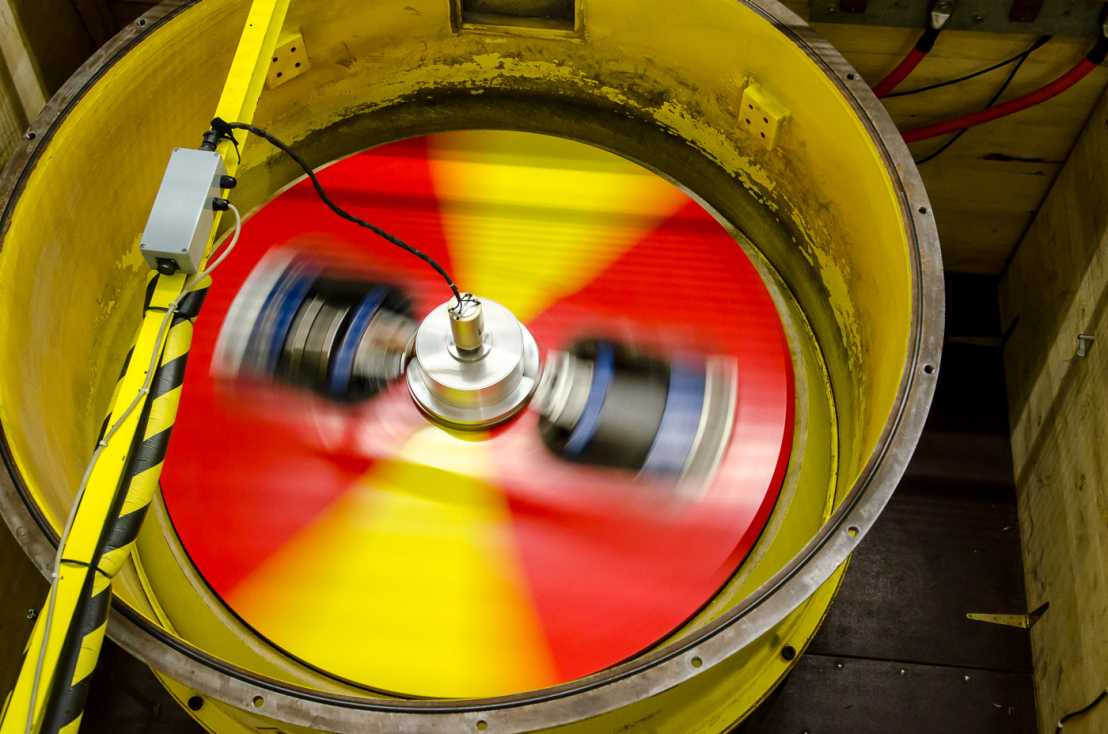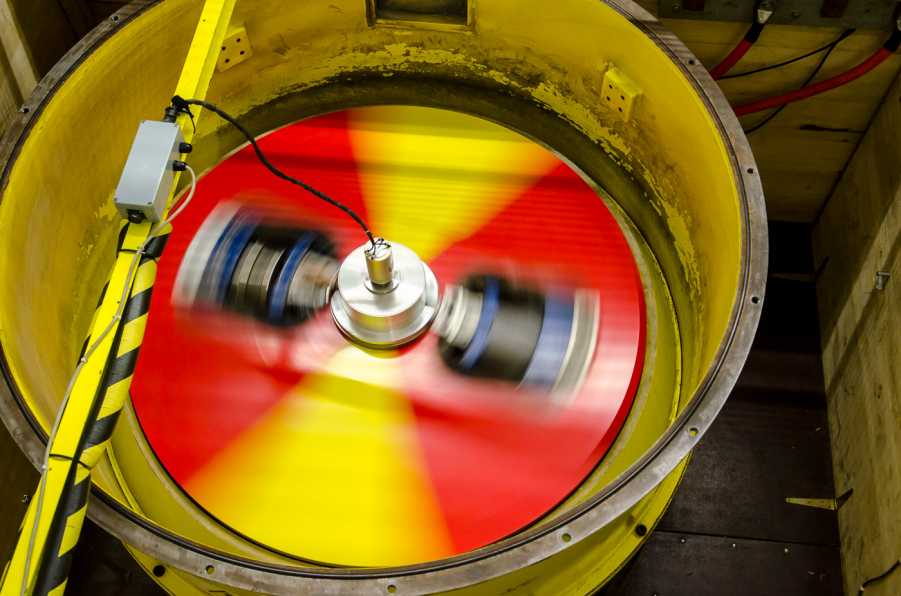Centrifuge
The centrifuging piston cylinder is a world-wide unique instrument: A centrifuge combined with a conventional high pressure devise, a piston-cylinder.

The centrifuging piston cylinder consists of a minimized 42 kg lightweight, all integrated single stage piston-cylinder and a large centrifuge that has a rotating table with two apertures for payload and counterweight. The centrifuging piston-cylinder itself contains a 14 mm bore hosting a 36 mm long furnace allowing for capsules sizes of 4 mm outer diameter and 6-7 mm length. This is the same dimension as being used in most of our standard piston-cylinder apparatus. The centrifuge piston-cylinder is mounted on a rotating 860 kg steel table with a diameter of 1.4 m. With the sample positioned at a radius of 32 cm a maximum acceleration of 3000 g is reached at 2850 rpm: at this frequency, the outer table rim moves at a speed of 753 km/h.
The centrifuge was designed with and constructed by Neil Baker of g-max, Scottland; and physically built by Braodbent Ltd., Huddersfield, UK.
Lab impressions
-

Miniturised non-endloaded piston cylinder prepared for usage in the centrifuge. The pressure assembly within this device is of 14 mm diameter; the same dimensions as being used in other presses of our laboratory. -

On the left hand side the piston cylinder is ready-to-go for centrifuging and heating; on the right hand side the counterweight (with a similar mass distribution) resides. A capillary connects the hydraulic ram of the piston cylinder to the (invisible) pressure transducer located exactly in the rotational axis of the centrifuge. Pressure is only monitored during centrifuging but can not be changed. The round box in the rotational center hosts the on-board electronics. -

The centrifuge rotating at 200 rpm.
Technical specifications of the single stage non-endloaded piston cylinder
- Pressure range: 3 - 18 kbar (0.3 – 1.8 GPa)
Temperatures up to 1250°C with standard straight graphite furnace (currently we limit the slip-ring stack to 300 amps of current), higher temperatures are achievable using stepped furnaces - Piston bore: 14 mm
- Piston ram: 35 tons
- Assembly: NaCl (or talc) -pyrex - MgO, with straight or stepped furnace
- Sample capacity: max. 5 mm capsule O.D., max. 8 mm length
- Construction: 2002-2003, in service since Febr. 2004
Technical details
Heating and thermal gradient
Although the piston cylinder is minimized and reduced to 13 pieces, it hosts a standard salt/talc-pyrex-graphite-crushable MgO 14 mm O.D. assemblage with a furnace of 36 mm length, 8 mm O.D. and 6 mm I.D, thus resulting in standard piston cylinder temperature gradients of 5-10°C (at 1100-1250°C) over the capsule length (typically 4 mm O.D., 6-7 mm length). Temperature is measured by a B-type PtRh-thermocouple and controlled by a standard Eurotherm control unit to nominally within ±1°C. Up to 300 A current are transmitted through a water-colled 40-ring slip-ring stack located at the lower end of the hollow rotational axis. Cooling water to the piston cylinder is provided through the center of the lower slip-ring stack and through tubing positioned exactly in the axis. Water flows radially through the piston cylinder pressure vessel and is finally centrifuged outwards, where the water spray is collected by a conical ring running around the rotation table.
Pressure
Oil pressure in the hydraulic ram is measured and monitored on-board by a standard pressure transducer mounted vertically in the axis and connected to the hydraulic ram (which in turn is integrated into the piston cylinders base plate) by a NovaSuisse 4000 bar capillary. Pressure cannot be changed during centrifuging but only statically through a standard hand pump. The pressure and temperature mV readings are converted on-board to a 4-20 mA signal, resulting in a perfectly smooth and rotation speed independent control signal. The latter signals is transmitted through a 16 channel slip ring stack at the upper end of the rotation axis.
Static equilibration
Many experiments consist of two steps: first, chemical equilibration of e.g. melts and solids at the temperature and pressure of interest at static conditions for 12-120 hours, and secondly, physical segregation of the equilibrated melts/crystals by centrifuging for 3-36 hours at typically 400-1000 g. When chemically equilibrating the experiments at static conditions, the heating current is directly provided to the piston cylinder without using the lower slip ring stack.
Safety
The essential safety parameter is centrifuge vibration which is kept to less than 0.8 mm/s at 1800 rpm (equivalent to ca. 1000 g) by balancing the table to better than 10 gram. Nevertheless, the centrifuge does not have a breaking system and it takes about 25 minutes to cast down from 1800 rpm. As an additional safety, oil pressure, temperature, cooling water flow, furnace resistance, and heating power are computer monitored and any significant deviation after the startup phase of the experiment would result in immediate shutdown of the centrifuge and heating.
Contact
Inst. für Geochemie und Petrologie
Clausiusstrasse 25
8092
Zürich
Switzerland